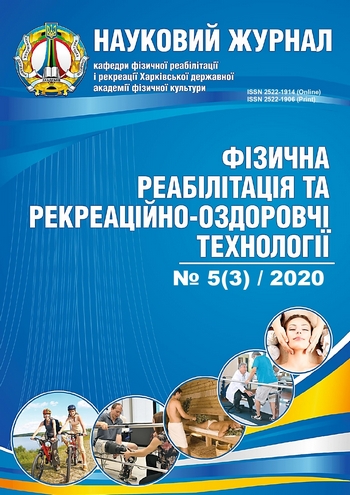The use of a simulator for the fingers of the brush in the rehabilitation of patients with the consequences of cerebral strokes
DOI:
https://doi.org/10.15391/prrht.2020-5(3).01Keywords:
нейрореабілітація, механотерапія, тестування, м’язова сила, спастичністьAbstract
Objective: To improve upper extremity recovery in patients with hemiparesis due to stroke using a finger simulator. Material and methods: 50 patients with hemiparesis due to a stroke with muscle strength in the hand - 3 points and degree of spasticity - 1-2 points were selected. Two groups were formed, in the 1st group in the rehabilitation complex a simulator for the fingers of the hand was used, in the control group - not. Results: a simulator for fingers and a set of exercises were developed. Measures were taken to restore hand function to patients of both groups. The effectiveness of using the simulator was proven by tests that showed a greater decrease in spasticity and an increase in muscle strength in patients of the I group. Conclusions: the use of a simulator for the fingers of the hand in the complex to restore the function of the hand in patients with hemiparesis improves the functional capabilities of the hand in comparison with rehabilitation without the use of the simulator.
References
Белова А.Н., Прокопенко С.В., Булюбаш И.Д., Григорьева В.Н., Можейко Е.Ю. Нейрореабилитация. – М., 2010. – 1288 с.
Ондар В.С., Ляпин А.В., Прокопенко С.В., Аброськина М.В., Живаев В.П., Прокопенко В.С. Диагностика асимметрии шага при синдроме центрального гемипареза с использованием индукционного анализатора параметров ходьбы // Сибирское медицинское обозрение. – 2010. – № 3. – С. 37-40.
Прокопенко С. В., Можейко Е. Ю., Алексеевич Г. В. Возможности восстановления тонкой моторики кисти с использованием сенсорной перчатки у больных, перенесших инсульт // Сибирское медицинское обозрение. – 2014. – № 2. – С. 72-77.
Ullberg T, Zia E, Petersson J, Norrving B. Changes in functional outcome over the first year after stroke: an observational study from the Swedish stroke register. Stroke 2015 Feb;46(2):389-94.
Проказова П.Р., Пирадов М.А., Рябинкина Ю.В., Кунцевич Г.И., Гнедовская Е.В., Попова Л.А. Роботизированная механотерапия с использованием тренажера MOTOmed letto2 в комплексной ранней реабилитации больных с инсультом в отделении реанимации и интенсивной терапии. Анналы клинической и экспериментальной неврологии 2013;7(2):11-5.
Indredavik B, Fjaertoft H, Ekeberg G, Løge AD, Mørch B. Benefit of an extended stroke unit service with early supported discharge: a randomized, controlled trial. Stroke 2000 Dec;31(12):2989-94.
Langhorne P, Taylor G, Murray G, Dennis M, Anderson C, Bautz-Holter E, Dey P, Indredavik B, Mayo N, Power M, Rodgers H, Ronning OM, Rudd A, Suwanwela N, Widen-Holmqvist L, Wolfe C. Early supported discharge services for stroke patients: a meta-analysis of individual patients’ data. Lancet 2005 Feb;365(9458):501-6.
Ottenbacher KJ, Jannell S. The results of clinical trials in stroke rehabilitation research. Archives of Neurology 1993 Jan;50(1):37-44.
Прокопенко С.В., Можейко Е.Ю., Алексеевич Г.В. Возможности восстановления тонкой моторики кисти с использованием сенсорной перчатки у больных, перенесших инсульт. Сибирское медицинское обозрение. 2014;2:72-77
С.В. Прокопенко, Е.Ю. Можейко, Г.В. Алексеевич Методы оценки двигательных функций верхней конечности // Журнал неврологии и психиатрии. – 2016. – №7. С. 101-107.
Lin K, Chuang L, Wu C, Hsieh Y, Chang W. Responsiveness and validity of three dexterous function measures in stroke rehabilitation. Journal of Rehabilitation Research & Development. 2010;47(6):563-572. doi: 10.1682/jrrd.2009.09.0155.
Downloads
Published
Issue
Section
License
Copyright (c) 2021 В.В. Щетинін, О. Г. Скрипка, Р.О. Бобошко, І.С. Дондорєва

This work is licensed under a Creative Commons Attribution 4.0 International License.

 Dear authors!
Dear authors!